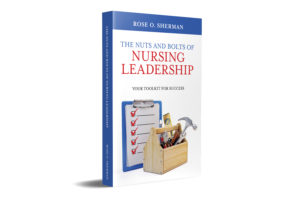By Rose O. Sherman, EdD, RN, NEA-BC, FAAN
Now is a challenging time to be a nurse leader. Some wicked problems exist in healthcare environments, and tough choices must be made often without data. Some examples presented to me recently include the following:
- Should we move forward on a 3rd Magnet redesignation in 2023? Our turnover is high, and engagement is low. I don’t believe many nurses would describe our hospital as a magnet environment right now.
- Should we change a long-standing policy on entry-level education for RNs? We can’t get enough BSN nurses. How do we balance this against the need to staff our units?
- Should we hire an interim manager to replace the nurse manager because we have no candidates, OR should I ask one of my current overworked leaders to manage the unit?
- Should we hold nurse managers accountable for performance metrics when their units are poorly staffed?
- Should we centralize our nurse staffing and scheduling?
- Should we implement multiple shift options on our units?
- Should we hold new nurses accountable for working nights and weekends as part of our employment contract? We have staff bringing in medical excuses.
- Should we continue using travel nurses to supplement our core staff when our organization is in financial trouble?
- Should we prosecute patients and families who assault our staff?
These are not easy choices, but sometimes models of decision-making can help in evaluating choices. In his book, Invent and Wander, Jeff Bezos points out that sometimes we think about all of our decisions in the same way when they are not. He divides decisions into two categories. The first category is one-way-door decisions. These are critical decisions that are highly consequential and usually irreversible. To change one’s mind after the fact can lead to disaster. Bezos believes these decisions should be heavily debated and analyzed from several different vantage points, even when you have a great deal of data.
There is a second type of decision; Bezos calls it a two-way-door decision. These decisions are reversible. If the decision proves to be wrong – you change. Not as much debate is needed with two-way-door decisions because they can be undone.
So the first step in any tough choice is to determine whether it is a one-way-door or two-way-door decision. The answers could be different across organizations. If we look at the list of tough choices above, moving to centralized staffing and scheduling or not moving forward on Magnet redesignation could be a one-way door for some leaders but not others.
Bezos offers an excellent strategy about how to manage dissent. He believes you will rarely reach a full consensus on a decision. With some decisions, knowing the right thing to do can be challenging. Bezos recommends using a disagree and commit approach when you find yourself in this position. As a nurse leader, you would tell your team that robust debate is good, but a decision must be made at the end of the day. Those who don’t agree with the decision are asked to disagree but commit. Bezos jokingly says that sometimes he needs to serve as the “chief slowdown officer,”, especially with the one-way-door decisions. This is advice worth taking.
Read to Lead
Bezos J. Invent and Wander: The Collected Writings of Jeff Bezos. Harvard Business Review; 2021.
© emergingrnleader.com 2022
Workshops are now also available onsite or hybrid.
Our Most Popular Right Now – Become the Boss No One Wants to Leave: Nurse Recruitment and Retention in Turbulent Times Retention WS Flyer
Give your leadership team the gift of a highly rated webinar – Nursing Leadership in 2022: Rebooting after a Life-Quake A Nursing Leadership Reboot Workshop
If you have a lot of new leaders, consider doing a Nuts and Bolts of Nursing Leadership Program – Nuts and Bolts Flyer Final
Read the Nurse Leader Coach – Available at Amazon and Other Book Sellers
Recommended Book by the Association of Critical Care Nurses – The Nuts and Bolts of Nursing Leadership: Your Toolkit for Success




 LinkedIn
LinkedIn Instagram
Instagram